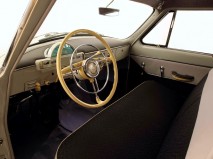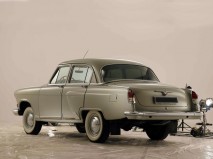1962 GAZ-21 Volga
The Volga was stylistically in line with the major United States manufacturers of the period, and incorporated such then-luxury features as the reclining front seat, cigarette lighter, heater, windshield washer and 3-wave radio.
The Third Series was produced from 1962 to 1970. The 1962 models dropped the leaping deer hood ornament, and had a new grille. It used a 6.7:1 compression engine of 75 hp (56 kW; 76 PS) with an optional 7.65:1 compression of 80 hp (60 kW; 81 PS) (usually reserved for the export models). The headliner changed from cloth to vinyl, and the radio became optional. It was offered as the standard M21L, M21T taxi, and right-hand drive M21N export model.
Also in 1962, GAZ advertised a station wagon/estate model, the M22; most of these were exported or reserved for official use. The first station wagons/estates were delivered in 1963, and were designated M22 (75 hp (56 kW; 76 PS)), M22G (export, 75 hp (56 kW; 76 PS)), M22T (export, 85 hp (63 kW; 86 PS)); ambulances were M22B (75 hp (56 kW; 76 PS)) and M22BK (85 hp (63 kW; 86 PS)). An M22 prototype four-wheel drive station wagon/estate was also built, as was an M22A van.













